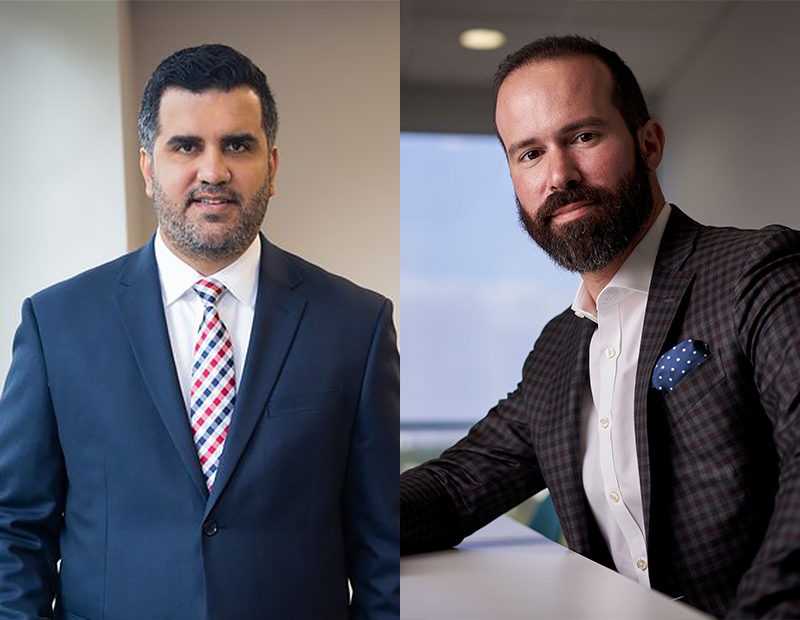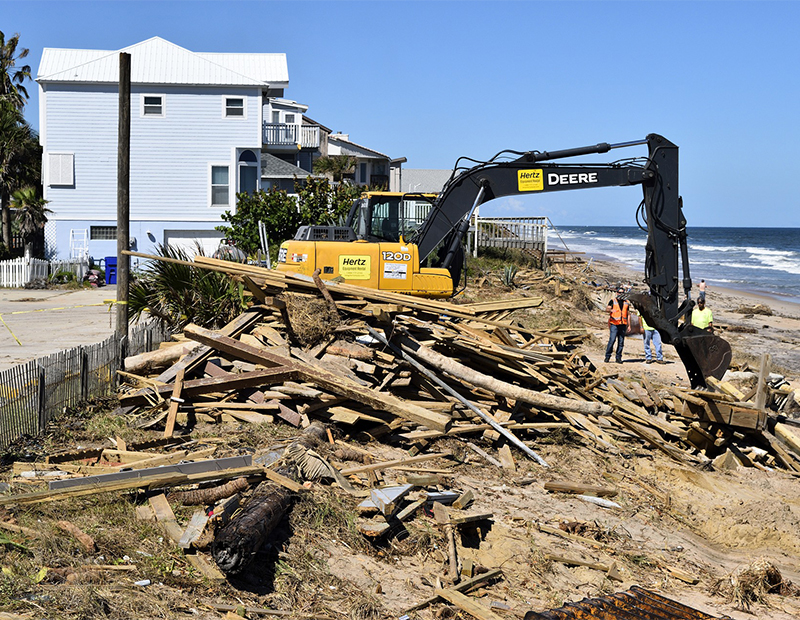Florida’s Take on the Climate Crisis
Sebastian Jaramillo, partner with law firm Wolfe Pincavage, and Luis Gazitua, partner at JAG Insurance Group, speak about issues arising from climate change in the Sunshine State.

(Left to right) Sebastian Jaramillo, Luis Gazitua. Images courtesy of Wolfe Pincavage and JAG Insurance Group
In the past decade, Florida has been facing increasingly serious problems caused by extreme weather events, particularly in the southern region. Hurricanes Irma and Michael, which made landfall in the state in 2017 and 2018, respectively, were especially destructive, their financial damage surpassing $75 billion combined, according to the National Hurricane Center.
The state’s officials are taking steps to address the imminence of sea-level rise, given the expected increased frequency and severity of flooding through 2050. One such step is the 10-year, $600 million stormwater management initiative that started in 2013 in Miami Beach and consists of elevating the roads and the installation of powerful water pumps. To find out more about the state’s methods of mitigating the risks associated with climate change in the Sunshine State, Commercial Property Executive talked with Sebastian Jaramillo, partner with Miami-based boutique law firm Wolfe Pincavage, and Luis Gazitua, partner at JAG Insurance Group.
What measures are being taken to minimize the threat to existing as well as future real estate assets? What resilience strategies are actively being applied in Florida?
Jaramillo: The City of Miami recently launched the Miami Forever Bond project to raise funds to fight off rising sea levels. The City also formed the Climate Resilience Committee to prepare recommendations to combat problems stemming from climate change. Miami-Dade County is also working with the U.S. Army Corps on a three-year study to develop strategies to combat rising sea levels.
Are Florida policymakers aware of climate change and the direct consequences it brings to the state’s real estate market?
Jaramillo: Florida policymakers are aware of the consequences, but their response seems to be slow. There have been steps taken to address some of the issues caused by increased temperatures, but the measures are minimal and not aggressive enough to properly address the issue.
How are discussions on warmer global temperatures and the destruction these inflict affecting real estate prices in the region? Are these talks influencing investment in the state?
Jaramillo: Current discussions on rising temperatures have not seemed to affect market prices as a whole. Investment in the state of Florida remains strong. That being said, once buyers or lenders start adjusting their long-term goals as a result of increasing sea level, it is inevitable that it will lead to an adjustment in the market.
The high-end condominium market has already cooled off, most likely due to diminishing demand from South America and oversupply in the market. There will be more market corrections as the discussions about warmer temperatures continue to get more attention.
READ ALSO: Energy Choices, Climate Change and Risk Management
How have the state’s building codes changed throughout the last decade?
Jaramillo: A number of counties in the state of Florida are raising their height requirements for waterfront properties and a few have chosen to adopt some of the more stringent requirements of the South Florida building code in order to minimize the damage caused by storm surges.
Which segment is more conscientious of the climate risk: investors or owners?
Jaramillo: Investors are more conscientious, especially when making long-term investments. Many owners are relying on policymakers to warn them about this issue and the response from policymakers is lagging.
To what extent is climate change putting pressure on the insurance industry?
Gazitua: It’s a continuous conversation. Natural disasters are increasing and the events are becoming bigger and stronger. The pressure is there to model and price. However, the unpredictability of the events makes it difficult to price accordingly or craft the proper policies.
From an insurance perspective, how accurately are reflected the costs of climate change in Florida? How do flood maps affect policy prices in the state?
Gazitua: Banks are already only approving short-term loans on coastal properties. Just one news report can plunge real estate value. Consumers are often wondering if it’s too late to sell. The real estate market is already feeling the effects of climate change.
As for flood maps affecting policy prices, the first thing to understand is flood maps dictate whether your lender will require you to buy flood in the first place. It goes from being optional to being a lender requirement. The Federal Emergency Management Agency remaps every few years which means sometimes a consumer finds that it becomes a requirement after years not having to purchase it. The flood map is what affects all pricing. Since flood is mostly through the National Flood Insurance Program, that pricing is locked into wherever your area falls on the map.
READ ALSO: How Climate Change Is Affecting Real Estate Values
Please detail the differences between homeowners’ insurance, flood insurance, personal property coverage and the underwriting of flood coverage policies.
Gazitua: Homeowner’s insurance covers the actual structure and anything attached. Flood insurance covers the structure and the contents if there is damage due to rising water during a storm. Meaning if there is rising water due to a burst pipe, that would fall under your homeowner’s policy, not flood.
Personal property coverage is a sublimit of your homeowners’ policy that covers the contents of your house (TVs, appliances, furniture etc.). It can also be a sublimit on your flood policy. Flood coverage will not be supplied on your homeowner’s policy unless explicitly stated. Flood underwriting depends on the elevation of your property. The closer you are to the water, the higher the risk, the bigger the premium.
So far, most of the attention has focused on physical risks. How much attention is being given to transition and liability risks?
Gazitua: None at this moment. Insurance is a very reactive industry. There won’t be coverage for these exposures until there are incidents that provide more data as to how much a claim would be required to pay out.
Can insurers do more to press policymakers to help mitigate and adapt to climate change?
Gazitua: No. Insurance is a for-profit industry. It would have to be mandated from a federal, state or local government. If lenders begin to require certain coverages then that would be pressure on insurers to make certain changes. So, really, the only way would be for consumers to vote in lawmakers concerned with changing insurance standards.
Should we expect to see withdrawal of private insurance cover from specific areas of Florida in response to climate change?
Gazitua: I don’t think so. It’s too early to assume companies will withdraw, if anything there will be certain companies that will capitalize on the situation to write more business in an area if companies withdraw. Fear is a powerful selling tool. A consumer will never find themselves without options.










You must be logged in to post a comment.